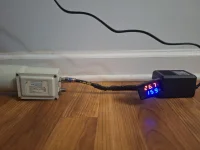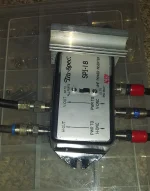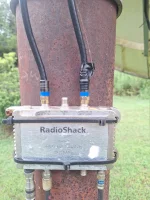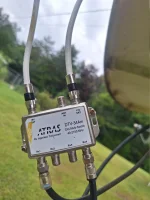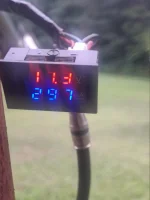Just a followup. I'll try to not be all over the place.
The disagreement to modify the satellites.xml file makes some sense. But I have been for a long time adding newly found blindscan transponders into the master file. And removing dead ones.
There have been 0 glitches using E-Channelizer as my channel editor. And the .xml is stored on my file server.
Perhaps different models of diseqc switches do in fact keep the lnb ports alive. In the case of the one I use, that's not so.
For the 22 kHz tone switches I have. When I get them to work. They are in fact a tone over voltage activated switch. So if port 1 gets no tone. Voltage to the lnb(f) is passed. Whether 13 or 18 volts.
And both of those findings do support your mentioning of warmup and stabilization time.
Not so bad with a pll with txco oscillator. With a DRO I imagine it could be very true. I've never used a DRO full time. There was a time when I pissed around with retuning a few old Directv and Dish ku lnbf's in the past. But not enough to see the stabilization time when one was fired up at freezing and lower temperatures.
Perhaps my biggest confusion and frustration during this whole ordeal was how to get power to the Norsat lnb pair over coax at a voltage that was not dependent on my receiver or ASC1.
And switch them accordingly per polarization. And use the ku lnbf that is side-carred to my scalar.. Using only two coax cables from my house.
In no instance could I get tone to pass through the DirecTV power inserter. It stopped completely at the receiver port RF capacitor.
I tried researching bias tee low pass filter designs and calculators. Swapped inductors, capacitors, etc. in the bias tee. No joy. None at all.
The 8X1 diseqc switch works on command. It has done a perfect job of switching between the now fried C2W and ku lnbf for a few years now.
It passes tone and diseqc packets to the lnb ports great.
If Enigma2 had a functiion to select diseqc switch ports according to polarity. That would be fckn fantastic. So far, the voltage switches I've seen still output 13/18 volts to the lnb ports.
Am I "out there" yet? Hope not.
I am not above modifying a diseqc swithch as per the "naughty mod" thread on satguys to provide 18 volts continuous to an lnb port. That would still put a stick in the spokes of powering 3 lnbs with two coax cables from my house to the dish.
Again. Wishing to offload the voltage and current load off of my receiver and dish mover.
I have 4 ACS1 movers here. With different faults. Including the one that got a zap last summer. The others I got for practically nothing.
Mine has a fried MCU. One that is repaired and in use now displayed "LNB IS SHORTED". A lot of sketching on paper of the section schematics. A lot of pulling good capacitors and MELF diodes to find the values of them. Whether it's a Zener or Schottky. From the the other boards that show the same ones not open or shorted.
Sourcing the parts from Digikey and Mouser, Newark. Easy. Place an order. Toss in a few comparators and such just because. Replenish my stock of other stuff for my bench.
Reverse engineering, drawing and redrawing the actual schematic. Much more difficult than the actual repair.
There aren't many robust diseqc actuator controllers out there. The one guy on sats.uk that made a more robust version like the ASC1 has said that he made his last one. Because the demand wasn't as he expected. He mentioned that since Titanium discontinued the ASC1. He tried to see if they were interested in selling his. I guess not much interest was given.
So now. People have the V-Box as the only option. Did I hear "Pull....*BLAM* "? How many are stacked in the closet when one bakes and is replaced?
I did spark the interest of the guy though with a seed. The Research Concepts RCK series of industrial actuator controls are out there for cheap. They have pc interface software and a RS-422 serial interface with full programming docs.
All that is needed is some Arduino MCU code or similar and a simple RS-232 level converter to trascode diseqc to their interface. It would be the last dish mover you would ever need.
And in the case of offset orbit satellites where a hobbyist did install an additional actuator. The RC controller could be programmed with a go-to preset to do it all automatically.
Arduino code for diseqc dish movers and diseqc decoders and the libraries needed is already out there. So starting from the ground up is not even needed.
Just some additional code and a human interface chunk of software like the ASC1 has is all that is needed. In a little standalone box with display.
He was very interested. I'm needing to complete a package of info and post it to a file transfer site.
If you've never spoken with anyone from satellitedish.com. Nice guys. I called and asked all of the right questions in the correct terminology.
Apparently commercial satellite folks use a DC block and simply tap into the coax stinger and shield and inject lnb voltage and his reports after the fact verified that it works.
As far as tone and diseqc went. No commercial users implement it. All headend, etc.
I'm "back on track" here. Maybe Back in Black. In a few days.
My final design is shown. A proper power inserter with selectable voltage for one port.
All done with two coax cables. One that supplies power to the inserter.
I am of the belief and resigned the thought that using a tone switch will ever work. It should. But getting the tone past a power inserter is a big not.
Before one, and after a diseqc switch out at the dish. Maybe so.
You look at your satellites.xml file and see every single satellite with a majority that you will never ever be able to receive.
Mine is now (has been for a long long time) trimmed with only the ones that I can swing in my arc. And all of the junk purged.
Because no diseqc port selection per polarity in Enigam2 is available.
My simple solution to create my own properly appended modified satellites.xml has worked great.
I get the most and best signal after hours and days of work tweaking my old 12 footer. Little warps and such that it may have.
131W was the the only satellite that skimmed the treetops. And a few of the transponders did need a few clicks of the actuator to peak signal. A pain every time I switched to a channel on one.
So why wouldn't a smart guy just create a satellite that took care of that and call it a day? Works for me. Right?



